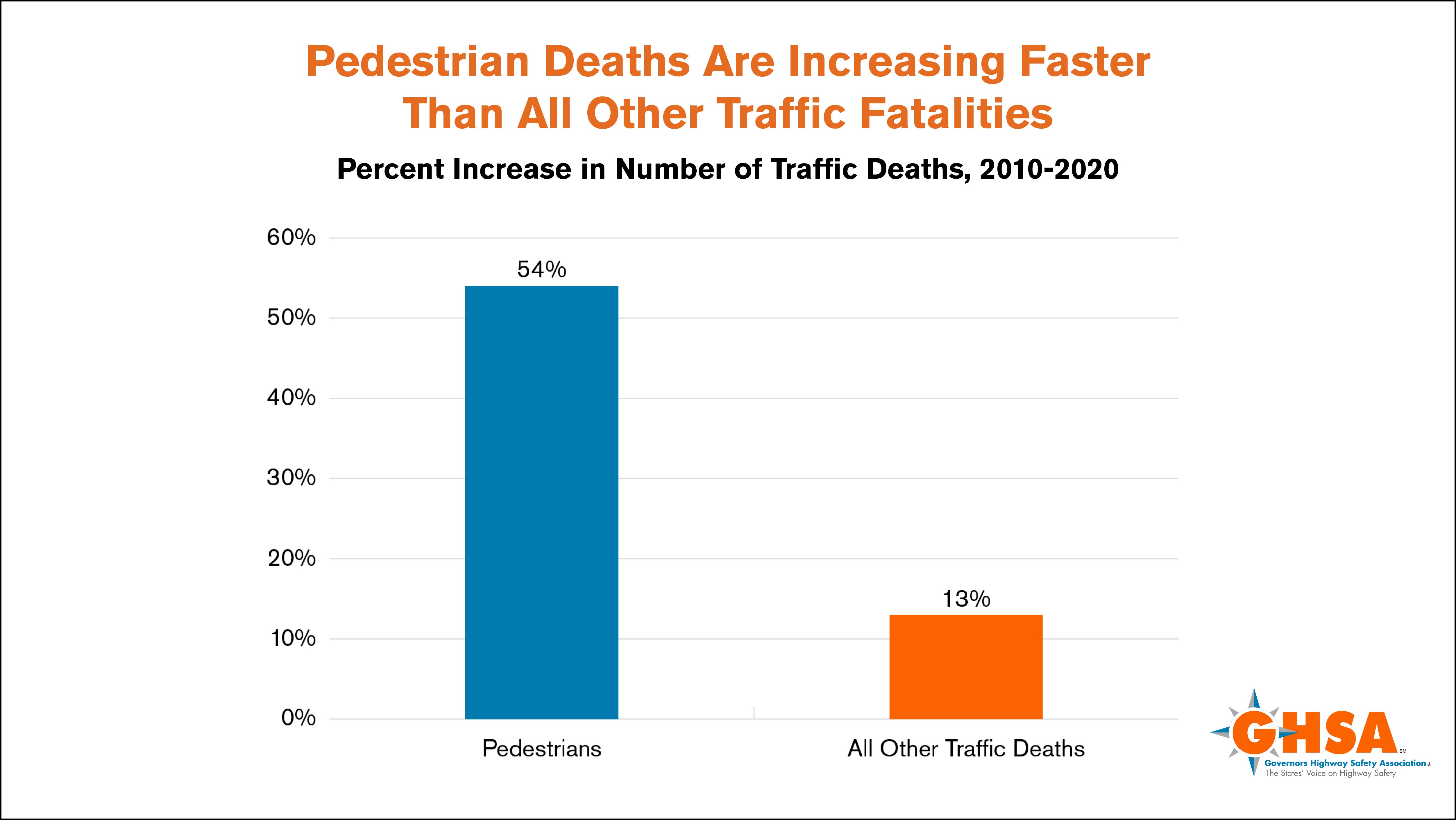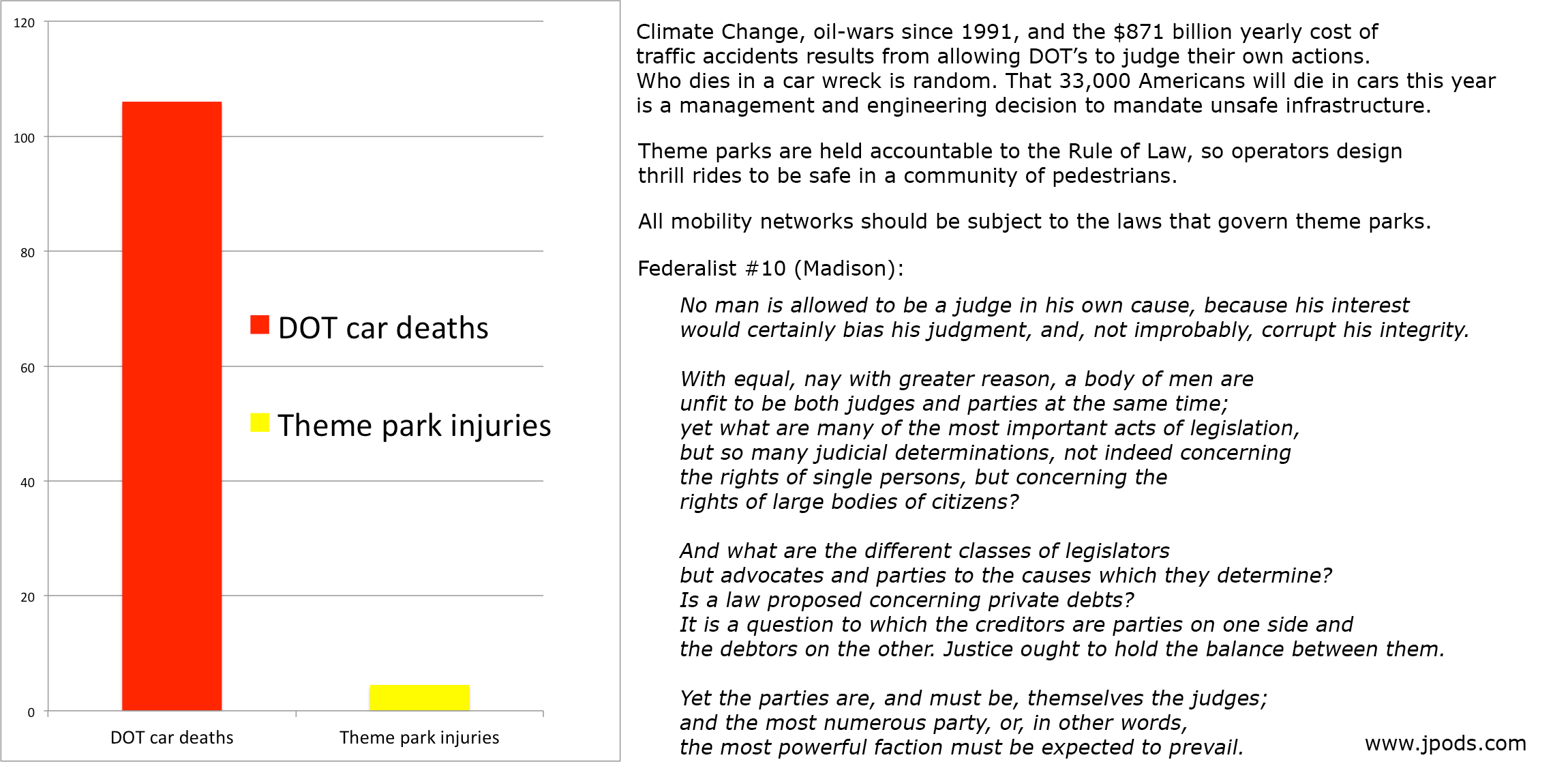Safer
Grade-separated JPods networks are 3,000 times safer:
- 3,000 times better safety regulations of states using the ASTM-International F24 Committee.
- By State.
- States are sovereign over internal improvements, are more creative, and are safer than federal regulations. Federal highways since the end of World War II have made American cities unwalkable, 400% less safe for pedestrians, addicted to foreign oil resulting in oil-dollar-funded terrorist attacks, oil wars since 1990, and Climate Change.
- National Safety Council injury data
- CDC: School Factors Associated With the Percentage of Students Who Walk or Bike to School, School Health Policies and Practices Study, 2014
- CDC: Road Traffic Injuries and Deaths—A Global Problem
- Morgantown’s PRT has had 5 minor in 50 years.
- Wuppertal suspended train has had 1 fatal accident in 121 years.
- Theme parks have a 3,000X better safety record than roads. Injury Rate per million of 3.7 on thrill rides versus 11,200 on roads. Cities should be as safe as theme parks (ASTM-International F24).
- JPods are certified to the higher standard of the ASTM-International F24.
Pedestrian Traffic Fatalities 2021, 7,485. Bike traffic deaths 2020, 1,260. Statista data on Injury rate per 100,000 licensed drivers in the U.S. from 1990 to 2020

Theme parks, regulated by ASTM F24 standards, have an injury rate of about 0.9 per million. DOTs, are self-regulated and have a an injury-rate of 11,200 per million. DOT injuries are 4.6 million medically consulted injuries per year. Radically safer transportation networks can replace the unsafe government monopolies.
Approximately 372 million guests safely enjoyed 1.7 billion rides at 400 U.S. amusement parks. Regulated by ASTM F24 standards, theme parks have a serious injury rate of .2 million visitors. In contrast, self-regulated DOTs have a death rate of 106 per million people (source: The Economic and Societal Impact Of Motor Vehicle Crashes, 2010). Simply put, you are 530 times more likely to die from an automobile, than get injured at an amusement park.
Few parents would allow their children to ride a roller coaster with the safety record of Department of Transportation. Governments have sovereign immunity to protect central planners for accountability. Sovereign immunity explains why theme parks and airlines are radically safer than government planned highways. Removing sovereign immunity will radically change safety regulations that result in accidents.

JPods uses safety standards from ASTM International Technical Committee F24. These standards resulted in the innovative spirit, care for customers and extraordinary safety record of the theme park industry.
Cars are unsafe. Morgantown’s PRT network has been operating without injury since 1975. In that same period of time, cars have killed 1.3 million Americans. That is 437 times the number of deaths suffered in the 911 terrorist attacks. Elevators, theme parks, JPods, any private business, would be driven out of business by lawsuits if they had a safety record as bad as cars.
According to a 2011 study conducted for AAA by Cambridge Systematics, the overall cost of crashes ($299.5 billion) equates to an annual per person cost of $1,522, compared to $590 per person annually for congestion ($97.7 billion overall).
 Wuppertal’s suspended train carries about 25 million passengers per year. It went into operation in 1903. Since 1903 there has been one fatal crash.
Wuppertal’s suspended train carries about 25 million passengers per year. It went into operation in 1903. Since 1903 there has been one fatal crash.
 Roller Coasters for all their apparent risk are 12,000 safer than cars. Car deaths are about 14 in every 100,000 people. Roller coasters are about one in 90 million; and many from intentional bad behavior.
Roller Coasters for all their apparent risk are 12,000 safer than cars. Car deaths are about 14 in every 100,000 people. Roller coasters are about one in 90 million; and many from intentional bad behavior.
 JPods combine proven roller coaster mechanics with computer networks to drive out the sources of variations that contribute to accidents.
JPods combine proven roller coaster mechanics with computer networks to drive out the sources of variations that contribute to accidents.
There are many hazards to travel caused by weather and road conditions. JPods preempts many weather hazards by traveling indoors on more durable surfaces. JPods designs are adapted to their locations. In most localities, JPods are designed to operate in sustained winds of up to 45 mph. Structures are designed to withstand 110 mph winds and 50 psi equivalent snow loads.
Study 2018: Cities with more transit use could cut road deaths by 40%
Archive Site
- State by State Regulation Table
- Safety
- 1973 Oil Embargo Lessons
- Jobs
- Access
- Climate Change
- Peak Oil
- Debt
- Weather
- Lifeboat Paradox
- Network Collapse Modeling
- Exactly How Far U.S. Street Safety Has Fallen Behind Europe, in Three Bombshell Charts
In contrast to the safety of theme parks, government infrastructure in America’s is rated D+. Highway infrastructure kills 33,000 people per year. Why, because it is the self-interest of the Governing to not put themselves in prison for their bad behavior.
So if:
- Children are poisoned by a governmnet mandated water supply in Flint, it is no one’s fault. No one goes to jail.
- Soldiers are sacrificed in oil-wars to secure foreign oil to power Federally mandated highways, it is no one’s fault. No one goes to jail.
- Bridges collapse and kill people in Minneapolis, it is no one’s fault. No one goes to jail.
- In the period Morgantown’s PRT network has been injury-free, 1.7 million Americans have been killed on the highway network. Yet, as stated by NJDOT Deputy Direct Joseph Bertoni “The NJDOT has reviewed PRT systems in the past and concluded that there is currently no practical application for these types of systems on either State or Interstate highways.”
If, on the other hand, someone gets stuck on an amusement ride, the theme park gets sued and is financially or criminally punished.
There is plenty of money to build sustainable infrastructure by converting the $billion in traffic costs into value.
https://www.calbike.org/urban-transportation-research-bike-fatalities/
Not vetted, but a good way to understand the issue if valid: http://www.debunkingportland.com/bicycles_kill_people.html
